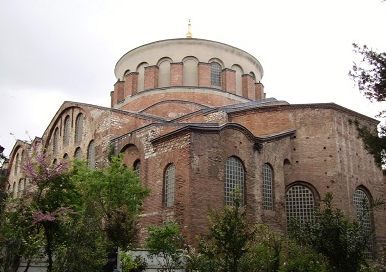The Hagia Irene Church is an early Byzantine structure located in the first courtyard of Topkapı Palace in Istanbul. Having served both religious and military functions throughout its history, the structure embodies traces of different eras under one roof. Today, it continues to function as a cultural venue, hosting concerts and exhibitions.
History
The Hagia Irene Church is located within the first courtyard of Topkapı Palace in the historical peninsula of Istanbul. It stands out as one of the first large church buildings constructed during the Byzantine Empire period. The earliest foundations of the structure date back to the reign of Roman Emperor Constantine I (324–337). Built at a time when Christianity was adopted as the official religion in Istanbul, this structure is one of the first churches of Byzantium.
Hagia Irene was damaged during the Nika Revolt of 532 and was rebuilt during the reign of Emperor Justinian I (527–565). In 740, it was damaged again by an earthquake and repaired by Emperor Constantine V. The cross motif placed on the apse during this restoration is considered one of the symbols of the Iconoclasm period. The building is among the rare examples that preserve architectural features from the early phases of the Byzantine era.
During the Ottoman period, the church was not converted into a mosque. Instead, it was used as the armory of Topkapı Palace and in the 19th century was transformed into the Military Museum. In the Republican era, the building was used for various cultural purposes and today holds the status of a museum under the administration of the Ministry of Culture and Tourism.

Hagia Irene Church (T.C Fatih Kaymakamlığı)
Architectural Features
The Hagia Irene Church is one of the early examples of Byzantine architecture. The centrally planned basilica has three naves. A large dome rises at the center of the main space. Columns surrounding the naos and the semicircular apse reflect the typical Byzantine character of the building. The narthex is located at the western end of the structure, where the entrance door is situated.
Instead of mosaic decorations, the interior features plain ornamentation characteristic of the Iconoclasm period. The large cross motif in the apse, containing no figures, represents the artistic understanding of this period. With various additions made over time, the structure carries the traces of different eras both architecturally and functionally.
Atrium
The atrium of Hagia Irene is one of the rare examples to have survived from the Byzantine period. With a U-shaped colonnade system, it is covered by a single-pitched roof. The colonnades are supported by columns made of Marmara Marble, with impost capitals. In the Ottoman period, various changes were made to the atrium, the ground level was raised, and the flooring was replaced with stone paving.
Narthex
The narthex consists of five sections. The central three sections are covered with domed vaults with soft curves, while the two outer sections are covered with cross vaults. The mosaics in the arches and vaults are believed to date to the 6th century, the period of Justinian I. The mosaic color palette includes red, green, white, dark blue, and gold tones.
Apse and Synthronon
The apse contains a large space covered with a half-dome. In this section is the synthronon, a semicircular seating arrangement with a stone base and brick steps. The synthronon consists of six steps, with square openings in the middle steps designed to illuminate the vaulted lower section. On either side of the synthronon are parekklesion cells, accessed through arched openings.
Gallery Floor
The gallery floor has a U-shaped plan, starting from the narthex and extending to the eastern ends of the naves. The galleries are separated from the nave by balustrades, and series of windows line the walls. Some walls of the south and west galleries date to the Byzantine period, while the vaults and buttresses belong to the Ottoman period. Today, access to the gallery floor is via wooden Ottoman staircases. Fresco fragments depicting the heads of saints have been found in the upper right gallery.
Ottoman and Republican Period Interventions
In the Ottoman period, a fire pump was placed in front of the apse as a precaution against fires, believed to have been installed in the mid-19th century. The flooring was also raised by 20 cm in accordance with interior level differences. The eastern ends of the galleries were converted into rooms for various uses.
In the Republican period, Hagia Irene was affiliated with the Hagia Sophia Museum Directorate and began to be used for cultural activities, especially concerts. As of 2024, the building is undergoing comprehensive restoration.
Collection and Cultural Use
Used as an armory during the Ottoman period, Hagia Irene was transformed into the Military Museum in 1846 by Damat Fethi Ahmet Pasha. Various weapons, armor, war materials, and military objects were exhibited here. Serving this purpose until the mid-20th century, the building was later used as a museum and cultural event venue.
Its acoustic qualities provide a favorable environment for classical music concerts and art events. For this reason, Hagia Irene currently hosts many international art organizations. To preserve and promote cultural heritage, the building is open to visitors only on special occasions such as exhibitions and concerts.
Hagia Irene Church's Place in Cultural Heritage
The Hagia Irene Church holds an important place in the historical and cultural fabric of Istanbul. It is notable as both a representative of early Byzantine architecture and an example of functional transformation during the Ottoman period. Additionally, it is one of the rare examples reflecting the effects of the Iconoclasm period on Byzantine art, making it a subject of scholarly research.
In its current state, Hagia Irene represents a multi-layered cultural heritage with its architectural structure, historical background, and functional transformations. It embodies the intersection of information and interpretations from both Christian and Ottoman-Turkish history. Today, it is carefully preserved for cultural heritage conservation and is followed with interest by academic circles.


